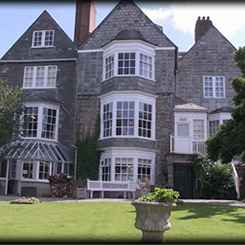Directions to the Main Museum
The main museum is currently closed.
From the Bus-stop and Multi-story Carpark on Westgate Street – follow Westgate Street down the hill past the multi-storey car park and take the first left onto Dockey. When you reach the crossroads you will see the gates of the Castle. Cross the road and go through the castle gate and follow the path through the castle grounds. When exiting the castle grounds carry straight ahead along Castle Street and Lawrence House is the fifth building on the left.
Directions to the Pop-Up Museum
From the Market Square on Broad Street – proceed to the High Street and the pop-up museum is the second door on the right opposite the Co-op.
Contact
Pop-Up Museum
Merchant’s House,
13, High Street
Launceston
PL15 8ER
Lawrence House
9 Castle Street
Launceston
Cornwall
PL15 8BA
(Currently Closed)
Opening Times
Tuesday – Saturday 10.30am – 4.30pm
Last entry 4.00pm
Telephone and Email
01566 773277
lawrencehousemuseum@yahoo.co.uk
Accessibility
The museum is an unmodernised Grade II* listed building and the galleries are located on the basement, ground and first floors. The ground floor is accessible from the main entrance on Castle Street with a ramp available for wheelchair users. The basement and first floor galleries are accessed via a central staircase. We do not yet have a lift.
The Mayor’s Parlour, War Room, Toy Room, Launceston Room, Railway Room and Herbarium are all located on the ground floor. They are fully accessible to visitors using wheelchairs and buggies. Please ask a steward for the access ramp to be deployed.
For those unable to access the basement and first floors but who wish to see or learn about a particular object or aspect of Launceston’s history, please get in touch and we will do all we can to assist. In the Herbarium on the ground floor there are photographic albums detailing the objects contained in the displays in the basement and on the first floor.
- For visitors with visual impairment, there are large print versions of the museum’s introductory guide to the galleries.
- Introductory gallery information is also available in a range of languages including French, Italian, Dutch and Spanish.
- There is no dedicated parking at the museum. The nearest public car parks are on Castle Street, Tower Street and Westgate Street.
- Assistance dogs are always welcome in the museum and non-assistance dogs are welcome in the gardens.
- Please do contact us in advance if you have any questions or if you would like us to assist you with accessibility during your visit.
- Please call or email us if you have any questions.

What can you expect to see?
There really is something for everyone to see and experience in the Lawrence House Museum.
First, there is the lovely Georgian Grade 2* listed building itself with its beautiful garden which has views across the valley to St Stephen’s. Next, as you begin to navigate through the town’s history inside the museum’s themed rooms you will enter the magnificent 18th century Mayor’s Parlour, and amongst many other things see a scale model of a section of the pre-Beeching railway and a toy room where you can play with the toys.
As you explore other rooms you will find one dedicated to famous natives of Launceston and its surrounding area including an astronomer, a poet, a chemist (the creator of our wonderful herbarium) as well as a professional sailor who later governed an Australian territory and in whose honour the town of Launceston in Tasmania was named. And that is just the ground floor!
Polyphon
The inner hallway houses a working mechanical musical instrument from the 1880s called a Polyphon. Ask the stewards on duty for a 1d coin to hear the popular tunes and dances of over 100 years ago. Upstairs, there are selections from our extensive costume collection as well as a history of the occupants of the house.





Garden
There are currently two distinct, accessible garden areas that are being sympathetically redesigned to include contemporary aspects to complement the Georgian building. In 2021 we extended the path and created a new herbaceous border. We aim to use the lower area to grow heritage vegetables, fruit and herbs. The long-term aim is for the garden to be utilised for educational purposes and cultural events. The previous occupants would have relished sharing their beautiful garden with visitors as we do now.
Great museum! I love traditional museums full of objects rather than glass boxes, too much writing and interactive screens. Keep it as it is!
